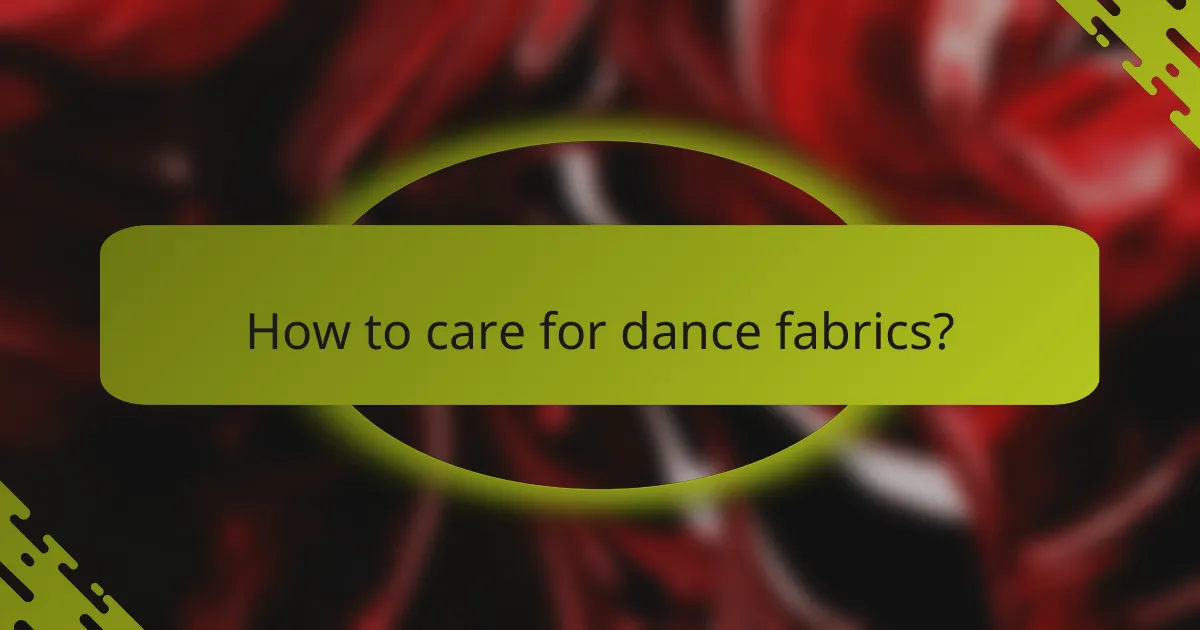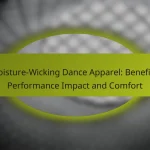When it comes to dance, the choice of fabric is crucial for enhancing performance and comfort across different styles. Ballet typically favors elegant materials like silk and cotton, while hip hop dancers benefit from durable and breathable fabrics that allow for dynamic movement. Understanding the specific needs of each dance style can help dancers select the most suitable materials to support their artistry and expression.

What are the best dance fabrics for ballet?
The best dance fabrics for ballet prioritize elegance, comfort, and functionality. Common choices include silk, cotton, and spandex, each offering unique benefits that cater to the specific needs of ballet dancers.
Silk for elegance and flow
Silk is often favored in ballet for its luxurious feel and graceful drape. This fabric enhances the visual appeal of costumes, allowing for smooth movements that reflect the artistry of ballet.
When selecting silk, consider its weight and finish; lighter silks can create a more ethereal look, while heavier options may provide more structure. However, silk requires careful handling and maintenance to preserve its quality.
Cotton for breathability
Cotton is a practical choice for ballet attire due to its breathability and comfort. It allows for air circulation, helping dancers stay cool during rehearsals and performances.
Look for cotton blends that include a small percentage of spandex for added stretch, ensuring that the fabric moves with the dancer’s body. Cotton is also easier to care for than silk, making it a reliable option for regular use.
Spandex for flexibility
Spandex is essential for ballet garments that require a high degree of flexibility and stretch. This fabric allows dancers to perform a full range of movements without restriction, making it ideal for leotards and tights.
When choosing spandex, consider the blend with other materials; a combination of spandex and cotton or nylon can enhance durability while maintaining comfort. Ensure the fit is snug but not overly tight to support movement without compromising circulation.

How to choose hip hop dance fabrics?
Choosing the right fabrics for hip hop dance is essential for comfort, performance, and style. Look for materials that offer durability, breathability, and warmth to support various movements and routines.
Polyester for durability
Polyester is a popular choice for hip hop dance fabrics due to its strength and resilience. It withstands wear and tear from rigorous movements, making it ideal for frequent use in classes and performances.
This fabric is also resistant to shrinking and stretching, ensuring that your dancewear maintains its shape over time. When selecting polyester garments, check for moisture-wicking properties to keep you dry during intense sessions.
Mesh for ventilation
Mesh fabrics are excellent for providing ventilation, which is crucial during high-energy hip hop routines. The open weave allows air to circulate, helping to regulate body temperature and prevent overheating.
Incorporating mesh panels into your dancewear can enhance comfort, especially in warmer environments. Look for garments that combine mesh with other materials for a balanced approach to breathability and support.
Fleece for warmth
Fleece is an ideal fabric for keeping warm during colder rehearsals or outdoor performances. Its soft texture provides insulation while remaining lightweight, allowing for ease of movement.
When choosing fleece, consider options that are breathable to avoid overheating during practice. Layering fleece with other fabrics can offer versatility, enabling you to adapt to varying temperatures while maintaining style.

What are the key considerations for dance fabric selection?
Selecting the right fabric for dance involves several key considerations, including comfort, moisture management, and elasticity. These factors significantly impact performance and the overall experience for dancers across various styles.
Comfort and fit
Comfort and fit are paramount when choosing dance fabrics. Dancers need materials that allow for freedom of movement without being restrictive. Fabrics should fit snugly but not tightly, ensuring that they do not chafe or irritate the skin during practice or performances.
For ballet, fabrics like cotton blends or spandex are popular for their soft feel and ability to conform to the body. In hip hop, looser fits with breathable materials like jersey or mesh are often preferred to facilitate dynamic movements.
Moisture-wicking properties
Moisture-wicking properties are essential for keeping dancers dry and comfortable. Fabrics that draw sweat away from the body help regulate temperature and prevent discomfort during intense routines. Look for materials labeled as moisture-wicking or breathable.
Common moisture-wicking fabrics include polyester and nylon blends, which are often used in both ballet and hip hop attire. These materials help dancers maintain focus and performance without the distraction of damp clothing.
Stretch and recovery
Stretch and recovery are crucial for dance fabrics, as they must allow for a full range of motion while returning to their original shape. Fabrics with good elasticity support dynamic movements and help maintain the garment’s structure over time.
Spandex is a key component in many dance fabrics, providing the necessary stretch. For ballet, a blend of spandex with cotton or lycra offers both comfort and flexibility, while hip hop styles may incorporate more relaxed fabrics with stretch to accommodate various movements.

How do dance fabrics impact performance?
Dance fabrics significantly affect performance by influencing movement, comfort, and the lifespan of the attire. Choosing the right material can enhance a dancer’s ability to execute movements effectively while ensuring they feel comfortable and supported.
Weight affects movement
The weight of dance fabrics plays a crucial role in how dancers move. Lightweight materials, such as spandex or nylon blends, allow for greater freedom and agility, making them ideal for styles like ballet and hip hop. Conversely, heavier fabrics may restrict movement, which can hinder performance.
Dancers should consider the specific demands of their dance style when selecting fabric weight. For instance, ballet often benefits from lighter materials that flow with the body’s movements, while hip hop may incorporate slightly heavier fabrics for added structure and style.
Breathability enhances comfort
Breathable fabrics are essential for maintaining comfort during dance. Materials like cotton and moisture-wicking synthetics allow air circulation and help manage sweat, keeping dancers cool and dry. This is particularly important in high-energy styles like hip hop, where intense movement can lead to overheating.
When choosing dance attire, look for fabrics labeled as breathable or moisture-wicking. These features can significantly improve the overall experience, especially during long rehearsals or performances.
Durability influences longevity
The durability of dance fabrics directly impacts the longevity of the attire. High-quality materials can withstand the rigors of frequent use, ensuring that costumes and practice wear last longer. Fabrics like polyester and reinforced spandex are often more resilient than lighter options.
Dancers should invest in durable fabrics, especially for styles that involve rigorous movements or frequent washing. Checking for reinforced seams and high-quality stitching can also enhance the lifespan of dance garments, making them a worthwhile investment.

What are the popular brands for dance fabrics?
Several brands are well-known for their quality dance fabrics, each catering to different styles and preferences. Popular brands include Bloch, Capezio, and Allegra, each offering unique materials and designs suited for ballet, versatile dance styles, and hip hop respectively.
Bloch for ballet
Bloch is a leading brand in ballet dance fabrics, known for its high-quality materials that provide comfort and flexibility. Their fabrics often include cotton, lycra, and mesh, which allow for ease of movement and breathability during performances.
When selecting Bloch products, consider the fit and style of the garment, as they offer a range of leotards, tights, and skirts designed specifically for ballet dancers. Look for features like adjustable straps and supportive bodices to enhance performance.
Capezio for versatility
Capezio is recognized for its versatile dance fabrics that cater to various styles, including jazz, contemporary, and tap. Their offerings include a wide range of materials such as spandex blends and moisture-wicking fabrics, making them suitable for different dance environments.
When choosing Capezio, focus on the type of dance you practice. For example, their fitted bodysuits are ideal for jazz, while their loose-fitting tops work well for contemporary styles. Pay attention to sizing charts to ensure a comfortable fit.
Allegra for hip hop
Allegra specializes in hip hop dance fabrics, providing bold and vibrant options that reflect the energetic nature of the style. Their materials often include breathable cotton and stretch fabrics, allowing for freedom of movement and comfort during routines.
For hip hop dancers, consider Allegra’s baggy pants and graphic tees that not only enhance performance but also showcase personal style. Look for pieces with moisture-wicking properties to keep you cool during intense sessions.

How to care for dance fabrics?
Caring for dance fabrics is essential to maintain their appearance and longevity. Proper washing and drying techniques can prevent damage and ensure that your dance wear remains in top condition.
Machine wash on gentle cycle
When washing dance fabrics, always use a gentle cycle on your washing machine. This setting minimizes agitation, which can cause wear and tear on delicate materials like spandex and chiffon.
Use cold water to prevent shrinking and fading. It’s advisable to separate colors to avoid bleeding, especially with vibrant fabrics commonly used in dance attire.
Air dry to maintain shape
After washing, air drying is the best method to maintain the shape and integrity of dance fabrics. Avoid using a dryer, as the heat can cause shrinkage and damage elastic fibers.
Hang or lay flat your garments to dry, ensuring they are in a well-ventilated area. This method helps preserve the fabric’s elasticity and prevents distortion, keeping your dance wear looking fresh for longer.










